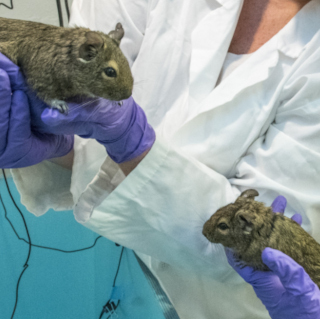Sentinel Health Program
Last Review Date: September 28, 2020
Purpose
The purpose of this document is to describe the sentinel program designed to monitor the health status of animals housed in LAR in an effort to prevent, detect and control the presence of specific infectious pathogens which may adversely affect animal health and/or influence research protocols. Sentinels cannot detect all pathogens but may serve as indicators of adherence to and effectiveness of barrier systems, containment areas, and preventive practices such as cage opening/changing, animal transport and procurement, use of protective equipment, and
Procedures
A. SPF mice
1. A dirty bedding exposure sentinel program monitors the health status of mice in
the SPF mouse facility (SB). The program employs semiannual serologic analysisof
outbred mice in order to screen for the presence of pathogens that may
confound research results. Once a year (first week of October) we test for MHV,
MVM, MNV, MPV, Sendai, TMEV, EDIM, and Mycoplasmapulmonis . Once yearly
(first week of April), we test for these same agents as well as PVM, Reo3, LCM, and
Ectromelia.
the SPF mouse facility (SB). The program employs semiannual serologic analysis
MVM, MNV, MPV, Sendai, TMEV, EDIM, and Mycoplasma
(first week of April), we test for these same agents as well as PVM, Reo3, LCM, and
Ectromelia.
2. Ectoparasite examination (microscopic examination of fur plucks on cellophane
tape) and endoparasite examination (perianal cellophane tapes for Syphacia
obvelata eggs, fecal flotation for Aspicularis tetraptera eggs, and direct
examination of cecal and proximal colonic contents for adults of both species)
are conducted semiannually on sentinel mice as well. Blood is collected
onopti-spot dried blood spot paper for serological testing. Ectoparasite and
endoparasiteexams are done on site using a stereomicroscope and an
optical microscope, depending on the testing methodology.
tape) and endoparasite examination (perianal cellophane tapes for Syphacia
examination of cecal and proximal colonic contents for adults of both species)
are conducted semiannually on sentinel mice as well. Blood is collected
on
endoparasite
optical microscope, depending on the testing methodology.
3. Serology analysis is conducted by IDEXX-RADIL
B. Rats
1. All rats are purchased from an approved vendor (i.e., Envigo CRL). They are
monitored semiannually for Syphacia muris using the cellophane tape test.
Serology is performed semiannually on extra rats from the primary populationand
includes RCV, Sendai, PVM, Parvo, TMEV, and Mycoplasma pulmonis (the first
week of October). In the spring (first week of April), the serologic panel includes
these agents as well as Reo3, LCM, MAD1, CARB, Hantaan, and Tyzzer’s disease.
Extra rats used for serology are necropsied and visual examination of cecaland
colonic contents done for adult pinworms.
monitored semiannually for Syphacia muris using the cellophane tape test.
Serology is performed semiannually on extra rats from the primary population
Extra rats used for serology are necropsied and visual examination of cecal
2. Serology analysis is conducted by IDEXX-RADIL
C. Rabbits
1. Rabbits are acquired from Myrtle’s Rabbitry. When rabbits are in the animal
facility , one rabbit is tested semiannually (not the same rabbit each time) for
Tyzzer’s disease, Treponema, and Encephalitozooncuniculi , depending on
whether rabbits are being housed long-term (> 4-6 months) or not.
Tyzzer’s disease, Treponema, and Encephalitozoon
2. Serology analysis is conducted by IDEXX-RADIL
D. Guinea pigs
1. Guinea pigs are acquired from Charles River Laboratories. There are currently no
guinea pigs in the animal facility. We do not house guinea pigs long-term in a
breeding or long-term experimentation situation at this time. If this situation
changes, we will expect to monitor semiannually for Sendai, PVM, PI3, and
Encephalitozoon cuniculi while adding once annually to this screen SV5, LCM and
Tyzzer’s disease
guinea pigs in the animal facility. We do not house guinea pigs long-term in a
breeding or long-term experimentation situation at this time. If this situation
changes, we will expect to monitor semiannually for Sendai, PVM, PI3, and
Encephalitozoon cuniculi while adding once annually to this screen SV5, LCM and
Tyzzer’s disease
E. Dwarf Hamsters
1. Dwarf hamsters were obtained from a closed colony. One dwarf hamsters is
tested semiannually for Sendai, LCMV and Clostridium piliforme.
tested semiannually for Sendai, LCMV and Clostridium piliforme.
2. Serology analysis is conducted by IDEXX-RADIL
F. Degus
1. Degus were acquired from a closed colony. The blood panel used for rats will be
used for the degus.
used for the degus.
2. Endo and ectoparasite checks will be conducted the same for degus as other
species
species
3. No degus will be euthanized for serology
4. Blood samples will be drawn from saphenous vein and sent to IDEXX-RADIL
G. Quarantine Sentinel Procedures
1. Mice received from vendors or sources other than those on the preferred list must
be quarantined for 6 weeks in a quarantine cubicle in HSB 004. Sentinel micewill
be used just as described above for mice in the SPF facility. Blood samples for
serology may also be taken directly from the new mice using lateral saphenous
vein collection methods. For additional quarantine procedures, see guidelines for
quarantine .
be quarantined for 6 weeks in a quarantine cubicle in HSB 004. Sentinel mice
H. Grain Mite Surveillance
1. On a semiannual basis, barrels containing animal feed are tested for grain mite
infestation. Clear tape is stuck on the bottom inside of each barrel linerand
placed on microscope slides. The slides are examined via microscopy for the
presence of grain mites or other parasites.
infestation. Clear tape is stuck on the bottom inside of each barrel liner
